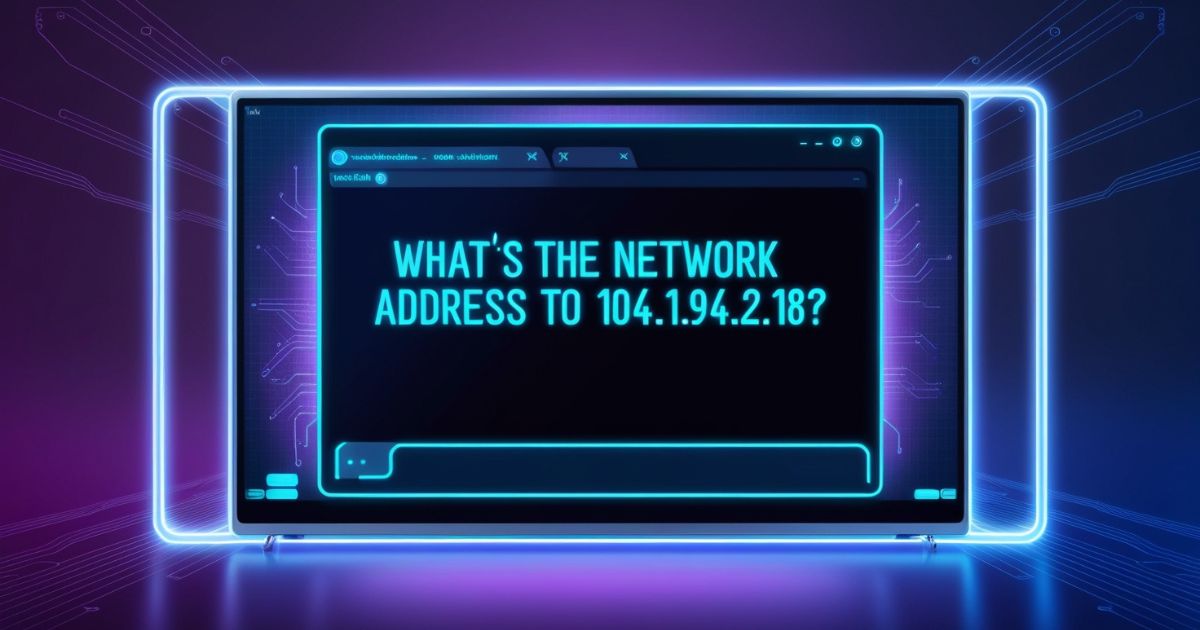In today’s digital landscape, understanding network addresses proves essential for anyone working with computer networks. This knowledge enables individuals and organizations to configure, manage, and troubleshoot their network infrastructures effectively. One specific question often arises: “what’s the network address to 104.1.94.218?” This article explores the concept of network addresses, provides insight into how to determine them, and answers this question.
Introduction
As we navigate through networking intricacies, IP addresses serve as the backbone for communication between devices. These unique numerical labels identify devices within a network, allowing for the smooth transfer of data. Network addresses play a crucial role in efficiently routing this data. By understanding the nuances of IP addresses and their respective network addresses, network administrators can maintain effective communication and troubleshoot issues effectively.
In this article, we will explore the fundamental aspects of IP addresses, delve into the mechanics of subnetting, and ultimately determine the network address for the specific IP of 104.1.94.218. By the end, readers will have a solid understanding of these concepts and their importance in network management.
What is an IP Address?
An Internet Protocol (IP) address acts as a unique identifier assigned to each device connected to a network that uses the Internet Protocol for communication. Think of it as a digital home address, allowing devices to send and receive information over the internet or local networks. Each IP address consists of a series of numbers divided into four octets, or sections, with each octet ranging from 0 to 255.
IP addresses fall into two main categories: IPv4 and IPv6. IPv4, the most widely used version, comprises a 32-bit number that provides approximately 4.3 billion unique addresses. However, as the number of internet-connected devices continues to grow, available IPv4 addresses rapidly deplete. IPv6 addresses this limitation by utilizing a 128-bit address space, significantly expanding the number of available IP addresses.
Understanding IP addresses proves crucial for navigating the complexities of modern networking, as they serve as the foundation for internet connectivity. This foundational knowledge equips anyone looking to troubleshoot network issues or design a robust network infrastructure.
The Structure of an IPv4 Address
IPv4 addresses follow a structured format, represented as four decimal numbers separated by periods. This format, known as “dotted-decimal notation,” makes it easier for humans to read while computers interpret it as a binary number.
For example, the IP address 104.1.94.218 can break down into its binary components: 01101000.00000001.01011110.11011010. This binary representation holds importance for how devices communicate within a network. Each part of the address serves a specific function: the initial octets generally identify the network, while the last octet identifies the specific device within that network.
Grasping this structure remains fundamental when analyzing and configuring networks. It empowers network administrators to make informed decisions about IP address allocation and management, ensuring that devices communicate effectively.
Understanding Subnet Masks
A subnet mask serves as a 32-bit number that divides an IP address into the network and host portions. It determines which part of the IP address refers to the network and which part refers to individual devices (hosts) within that network. Essentially, the subnet mask tells the network how many bits to use for the network address and how many for the host address.
For instance, a common subnet mask is 255.255.255.0. This configuration allocates the first 24 bits for the network and the remaining 8 bits for host addresses. This setup allows for up to 256 addresses within that network, although the first and last addresses remain reserved for the network and broadcast addresses, respectively.
Understanding subnet masks plays a vital role in effective network management, as they influence the size and scope of a network. Properly configuring subnet masks can help prevent network congestion and improve overall performance by segmenting traffic efficiently.
How to Determine the Network Address
To determine the network address for a given IP address, perform a bitwise AND operation between the IP address and the subnet mask. This process isolates the network portion of the IP address.
Using the IP address 104.1.94.218 and the subnet mask 255.255.255.0, we start by converting both the IP address and subnet mask into their binary forms.
Once we establish the binary forms, we perform the bitwise AND operation. This operation involves comparing each corresponding bit in the IP address and the subnet mask, resulting in a new binary sequence that reflects the network address.
Converting the resulting binary back to decimal reveals the network address, which in this case is 104.1.94.0. Therefore, when we use the subnet mask 255.255.255.0, the network address for 104.1.94.218 becomes 104.1.94.0. This calculation proves crucial for network management, as it helps define the boundaries of the network.
Example: What’s the Network Address to 104.1.94.218?
To determine the network address for the IP address 104.1.94.218, we previously used the subnet mask 255.255.255.0, resulting in the network address 104.1.94.0. However, it’s essential to explore how different subnet masks affect the network address.
Using a different subnet mask, such as 255.255.0.0, would yield a broader network address. In this case, a larger portion of the address space allocates to the network, allowing for more devices within that network. This configuration often benefits larger organizations or when a more extensive range of IP addresses proves necessary.
If we apply the subnet mask 255.255.0.0 to the IP address 104.1.94.218, we perform the same bitwise AND operation. The result would give us a network address that encompasses a larger range of devices. This example illustrates how varying subnet masks can dramatically alter network configurations and impact device connectivity.
Understanding these distinctions remains critical for network administrators tasked with designing efficient and scalable networks. Each decision regarding subnetting can significantly influence network performance and connectivity.
Other Common Subnet Masks and Their Network Addresses
In networking, various subnet masks accommodate different organizational needs and sizes. Each mask serves a specific purpose and determines how many devices can connect to a network. Some common subnet masks include 255.255.255.0 (/24), 255.255.254.0 (/23), 255.255.252.0 (/22), and 255.255.0.0 (/16).
With a subnet mask of 255.255.254.0, the network address for 104.1.94.218 would also differ. This mask allows for up to 512 IP addresses, accommodating larger networks. Each subnet mask corresponds to a unique network size, impacting the total number of devices that can communicate within that network.
Choosing the appropriate subnet mask based on the number of devices needing connectivity proves crucial for network engineers. The right choice prevents IP address exhaustion and ensures optimal performance. By understanding how different subnet masks alter network addresses, administrators can design effective network architectures tailored to specific organizational requirements.
Why Network Addresses Matter
Network addresses hold vital importance for several reasons. First, they facilitate efficient routing, enabling data packets to navigate complex networks. Each packet of data includes source and destination addresses, guiding it through routers and switches to reach its intended destination.
Second, network addresses play a crucial role in network management. Administrators use network addresses to segment networks, apply security policies, and monitor traffic. By understanding which devices belong to which network, administrators can effectively manage resources and troubleshoot issues.
Furthermore, network addresses remain essential for security measures. Firewalls and other security devices often use IP addresses to allow or block traffic. By properly configuring network addresses, organizations enhance their cybersecurity posture, protecting sensitive data from unauthorized access.
In summary, grasping network addresses remains fundamental for maintaining robust and secure network infrastructures.
Troubleshooting Network Address Issues
Even experienced network administrators encounter issues related to network addresses. Common problems include IP address conflicts, where two devices attempt to use the same address, leading to connectivity issues. When this occurs, the network may drop connections or fail to establish new ones.
To resolve such conflicts, administrators can implement DHCP (Dynamic Host Configuration Protocol) to automatically assign IP addresses to devices within the network. This method significantly reduces the likelihood of conflicts and streamlines the IP address allocation process.
Another common issue involves incorrect subnetting. If a device receives an IP address outside of its designated subnet, it may struggle to communicate with other devices. Understanding how to calculate and apply subnet masks remains crucial for troubleshooting this type of issue.
Utilizing network monitoring tools can also aid in identifying and resolving address-related problems. These tools provide insights into network performance, helping administrators pinpoint and address issues efficiently.
Conclusion
In conclusion, understanding network addresses serves as a foundational skill for anyone involved in networking. From recognizing the significance of IP addresses to calculating network addresses, such as What’s the Network Address to 104.1.94.218, this knowledge equips individuals and organizations to manage their networks effectively.
Through exploring subnet masks, routing, and network address management, we have established the importance of these concepts in ensuring efficient communication between devices. As networks continue to evolve, the ability to navigate these intricacies will remain essential for effective network administration.










